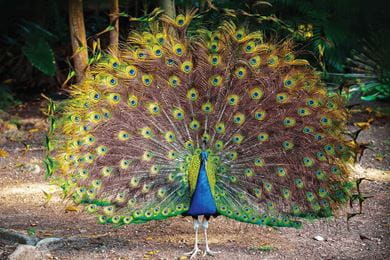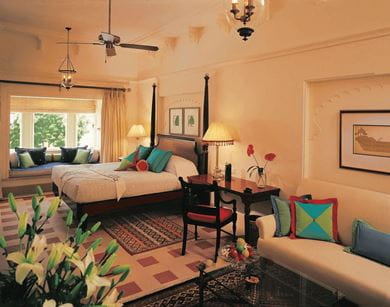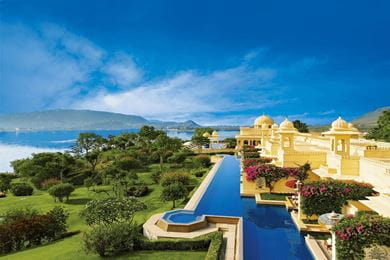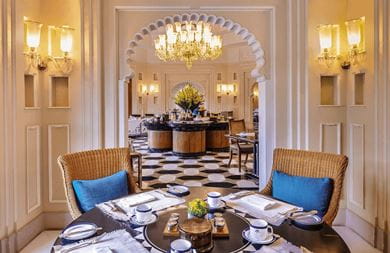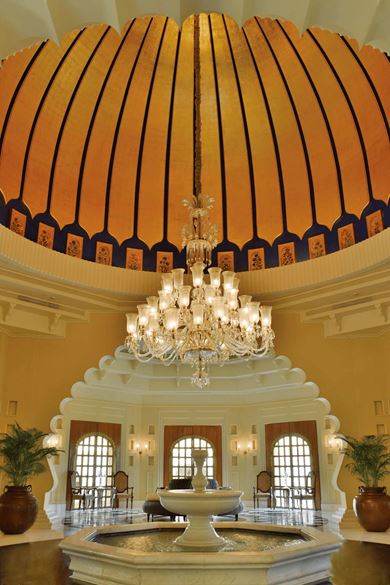







The Oberoi Udaivilas, Udaipur, brings together the finest in nature, luxury and impeccable service to offer an unforgettable holiday experience
The Vilas properties are India’s most famous and celebrated hotels. Ever since the first one - The Oberoi Rajvilas, Jaipur, opened in 1997, the Vilas properties have revolutionised hospitality in India and have regularly been rated as among the world’s finest hotels. The creation of the Vilas properties had its roots in an old fort that Mr. P.R.S (Biki) Oberoi, Executive Chairman of The Oberoi Group, bought in Rajasthan. While he was restoring the fort, he made several trips to the state to oversee the work.
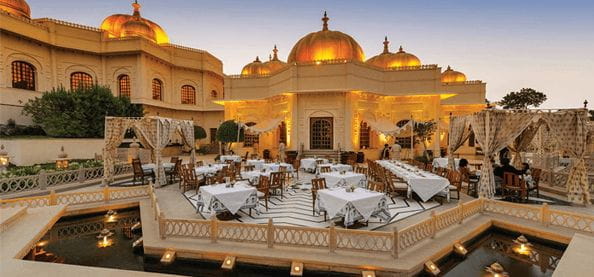
Most times he would stay in one of the so-called grand hotels of the region. Often, they looked grand as they had once been palaces, after all, but the guest experience was pathetic. Eventually, fed up of suffering on each trip, he began to take his own towels, his own sheets, packed food cooked by his own chef and even toilet supplies.
The experience got him thinking - why didn’t Rajasthan, the centrepiece of India’s tourism offering, have world-class luxury hotels?
The more he thought about it, the more bemused he got. Surely, it couldn’t be that difficult to run a good hotel in Rajasthan?
From that experience, came the idea for the first Vilas: The Oberoi Rajvilas, Jaipur. He built it to standards of luxury that were at the cutting edge of the international hotel industry and soon turned it into a global destination hotel, giving Rajasthan’s capital the hotel it had always deserved.
Other Vilas properties followed in quick succession. There was The Oberoi Vanyavilas, Ranthambhore next to the tiger reserve of Ranthambhore. The Oberoi Amarvilas, Agra became famous all over the world for its design: you could see the Taj Mahal from most of its rooms. Wildflower Hall, Shimla in the Himalayas – An Oberoi Resort at the foothills of the Himalayas, offered a taste of the Raj updated to modern global standards of luxury.
When it came to Udaipur, one of the world’s great destinations, a gem of a city that preserves the ethos of Rajasthan, Biki Oberoi was faced with a choice. Should he build a modern palace? Or should he do something more adventurous and daring? Naturally, he chose to do something much more daring. Next to Lake Pichola, the water body that is the heart of Udaipur, and directly across from the Maharana’s palace, lay 50 acres of forest land. In the old days, this had been part of the hunting grounds of the rulers of Udaipur. When hunting was banned in India, the area became a hilly animal-habited forest.
It had never been developed because the land was uneven and rocky. Construction would, by definition, be difficult. Besides, who would want to build on such uneven terrain? And local laws required many of the trees to be protected, making any development a complex and tricky task.
Biki Oberoi’s solution was to build a hotel that was unlike any that he had ever built before - perhaps the first of its kind in the world. He set aside 30 acres for the resort complex and decided that it would have just 87 rooms. That meant a ratio of one acre to every three guest rooms - more or less unparalleled in the hotel world.
Then, he resolved to protect the existing trees and to plant thousands of new ones. His resort would have the grandeur of a palace but would be one with nature. You could stare at blue skies, smell fresh air, walk on green grass and see trees nearly everywhere you looked.
Not only would the hotel be one with nature so that it rose organically from the hills, he would also keep it low. There would be just one storey to most of the wings - because the hotel was built on hills, the natural topography of the land meant that some rooms would seem higher than others.
Because he had so much space, he built The Oberoi Udaivilas, Udaipur almost like a small, sparsely populated city, with gardens and courtyards everywhere. To keep in with the sense of location and place, the hotel was built almost entirely from local ingredients. Every design element was derived from an Udaipur tradition and much of the workmanship was artisanal. Local handicrafts and works of local art were liberally strewn around the hotel - each room had at least one magnificent piece - and sometimes guests had the sensation that they were on an artistic tour of Mewar, the region that Udaipur is a part of. Of course, Biki Oberoi is a master of luxury, so all this was combined with unparalleled levels of luxury. The entry level room is 55.7 square meter (twice the size of most hotel rooms). A full one-third of all rooms and suites have either private or semi-private pools. Every single room has a sit-out area, many with views of the .
It was no surprise that when The Oberoi Udaivilas, Udaipur opened, it quickly became one of the world’s most celebrated resort properties. It has won too many awards to mention. But one is worth remembering.
In 2007 and 2015, The Oberoi Udaivilas, Udaipur was ranked as the best hotel in the world by the readers of Travel + Leisure magazine. Since then, it has rarely been out of most rankings of the top 10 hotels in the world. In 2015, the readers of Condé Nast Traveller in the UK rated it as the second best hotel in the world. In 2009, Forbes rated it among the World’s Most Excessive Hotels. And in India/Asia, it has won every award worth winning.
I first went to The Oberoi Udaivilas, Udaipur, in 2007, and was blown away by the sheer ambition of the venture and the brilliance of its execution. A decade ago, it seemed like a clear breakthrough in the world of hoteliering. I have been back thrice since then, and have loved it each time.
But when I went back this time to write this piece, I went with a more critical eye. Had the hotel maintained the standards that made it famous? Did it still seem so impressive and so precedent-shattering?
The simple answer is yes; it took my breath away, again.
There is, first of all, the romance of the welcome. You arrive at the City Palace end of Lake Pichola at The Oberoi Udaivilas, Udaipur’s own boat jetty. The staff are expecting you so there are cool towels and cold (or in the winter, warm) drinks. Your luggage is quickly loaded into one of the hotel’s boats and you make the journey across the lake to another more ceremonial welcome at The Oberoi Udaivilas, Udaipur.
Check-in is smooth and effortless. They give you a glass of champagne and you either sign the registration card under the massive chandelier that dominates the reception area or they walk you to your room, past hundreds of artefacts and a few cooing peacocks, and let you sign the registration on your own desk.
From then on, it’s an adventure. Assuming you don’t want to use your pool (if your room doesn’t have one, the hotel has two other large pools), you should explore the acres of grounds. Despite having been here before, I always get lost in the grounds because the hotel is full of surprises. You wander along a passageway and suddenly encounter a courtyard with fountains. You head in another direction and a garden magically appears.
Each guest will find an area of the hotel that he or she likes most, but my personal favourite is Kartikeya’s garden. This area is dominated by an antique statue of Lord Kartikeya, the son of Lord Shiva and Goddess Parvati. The statue guards the entrance to a large garden that is, appropriately enough, full of peacocks. It’s appropriate because the peacock is Kartikeya’s steed.
I have no idea whether the peacocks are aware of the connection or whether they just like this part of the hotel, but on each visit to the garden I counted at least six peacocks. In fact, you get the impression that they own the garden and you are just an interloper. No matter how close you get, the peacocks seem unconcerned. This is their own territory. Though peacocks can fly, they can only do so for short distances and not at a very great height. But Kartikeya’s peacocks don’t seem aware of these restrictions. Each day I would see them flying around, and on my last night there, one of them came to the courtyard and pool area outside my room and sat on a tree, watching us closely. Then, as it grew dark, he flew up to the tallest dome in the hotel and perched there, silently silhouetting against the darkening evening sky. It is an image that will live with me for a long time.
Because the hunting grounds that The Oberoi Udaivilas, Udaipur, is built on are hundreds of years old, there are many historical structures scattered around the property. My own favourite is a pavilion at the very end of Kartikeya’s garden, overlooking the lake. Apparently, it started out as a hunting lodge or a resting place for the Maharana and his courtiers between shoot expeditions. I am not a fan of hunting, but this structure fascinated me. It was built 200 years ago, and yet survives totally intact, its floors still gleaming in the sunlight. Most days, a peacock or two stand guard near the entrance.
I focus mostly on peacocks because of their ethereal beauty but The Oberoi Udaivilas, Udaipur, is an unlikely bird sanctuary of sorts. Each day, I would notice new and unfamiliar birds sitting on the trees. I asked Amit Kaul, the hotel’s General Manager, who is an avid birdwatcher, where these beautiful and unusual birds came from. Amit said that he had personally counted 120 different kinds of birds (which means the total number must be in excess of 200 or so, at the very least) and reckoned that most were migratory in nature. They had flown hundreds of miles from all over the world just to come here. I could see a certain logic to that. Each year, guests fly hundreds and thousands of miles to this fabled resort, so why should birds be an exception?
When it was finally the time to leave, I sat down to make a list of all the things I would remember about the hotel. Some of them were not out of the ordinary, at least in a Vilas context. There are three restaurants, the food is and the staff is skilled at setting up meals or snacks in the open-air setout area by the pools (both private and semi-private). In my case, the evening would start at 6.30 pm with the unusual combination of champagne and chaat - the hotel excels at Indian street food.
The spa is spectacular - but then I have come to expect nothing less from a Vilas. The staff-members are young, friendly and cheerful. Every single one of them goes out of his or her way to surprise you. Each evening I waited, fascinated to see what Sanchita, the housekeeper attached to my wing, would do. One night, she filled my bed with origami-style animal shapes made from towels. On another, she spelled out ‘good-night’ in rose petals on the floor of my room. And on my final night, she filled my poolside area with fairy lights that glittered in the Udaipur night.
As wonderful as all this was, there are two other things that I will remember most fondly about my stay at The Oberoi Udaivilas, Udaipur. The first is the air of quiet, unobtrusive service. Not only does nobody bother you unnecessarily (everything, from when you want your room cleaned to when you want to eat dinner is bespoke and organised around your convenience) but you never actually bump into staff in the corridors. (Though when you do, they are unfailingly charming). You don’t see servers carrying room service trays and you don’t have to walk around housekeeping carts.
I asked Amit how they managed this. After all, servers must have to travel from say, the kitchen to the rooms in this far-flung and spread out hotel. So why did I never see them? Amit told me the secret. Below the guest floors, carved into the rocks of the hill, is another floor. This is where all the services (laundry, kitchen etc.) are located. A series of lifts links this area to the guest floors. So when a server takes the lift up with your breakfast order, he or she rarely has to walk very far because each section has its own lift.
It is the kind of detail that most guests will not register at a conscious level. But at a subliminal level, the absence of waiters wandering around with trays or of corridors packed with staff adds to the luxury experience.
And, of course, it adds to the air of peace and serenity. What I will remember forever about The Oberoi Udaivilas, Udaipur, is how brilliantly the hotel combines stunningarchitecture with a sense of nature. The gardens, the peacocks, the migratory birds, the waters of the lake, are all unforgettable. The hotel has recognised that while man-made gardens can be wonderful, nothing competes with the wonders of Mother Earth.
That’s true luxury: where a hotel is designed to emphasise the beauty of nature while pampering its guests in every way known to man!
Nita Mukesh Ambani Cultural Centre brings to the city a vibrant space for the world of music, dance, ...
I sometimes feel as though the legacy of Lord Kitchener has pursued me all of my life. I studied his ...
In 1992, Prince Charles, the Prince of Wales and heir to the British Throne visited India along with ...
Should one risk a vacation in the middle of pandemic? I thought long and hard about it before decidi ...
The Mona Lisa traces back herself to her artist Leonardo da Vinci’s life at Château du Clos Lucé in ...
The Oberoi Beach Resort, Lombok has undergone rejuvenation and evolved into a destination of unrival ...
A vivid tour through the hottest Bree Street’s central reaches that we call home to the ethical food ...
The Oberoi Beach Resort, Sahl Hasheesh, offers a royal experience amidst the colourful sea life at E ...
Located at the junction of Aravali and Vindhya ranges, Ranthambhore National Park was once a private ...
William Shakespeare lived through one of the most turbulent yet thrilling era’s of English history ...
While central Melbourne has its own allure, the city’s charm lies in its diverse suburbs, each of wh ...
Adrian Rohnfelder, a photographer with a keen interest in volcanoes and adventure, shares his extrao ...
Witness the journey of a wooden instrument that broke all the records to become the backbone of Arab ...
To leap beyond imposed restrictive limits of existence is precisely what Dimpy Menon’s artworks spea ...
More than just a circus, Phare performers use theater, music, dance and modern circus arts to tell u ...
Peru is one of the peak experiences in travel. Nowhere on earth is there such an incredibly wide ran ...
The Oberoi Sukhvilas Spa Resort, New Chandigarh helps you get in touch with yourself so that you liv ...
The establishment of the British Empire greatly influenced the architecture and culture of India an ...
Complete with red sandstone fort, torch lit ramparts and ‘Haveli’ mansions, The Oberoi Rajvilās, Jai ...
Come aboard The Oberoi Zahra, Luxury Nile Cruiser for a delightful mix of luxury and history ...
The incredible Turtle Sanctuary at The Oberoi Beach Resort, Bali, is a must-visit for nature lovers ...
As part of the Beatles, arguably the most iconic rock band of all time, John Lennon and Paul McCartn ...
Oberoi Hotels & Resorts have won the hearts of many with its exquisite charm and glorious stays ...
When I work with a subject, whether it is landscape or nudes, I’m in a relationship with whatever’s ...
Portugal’s capital city of blues from the ubiquitous blue tiling adorning buildings to fado, the sou ...
My conceptual concerts initiate dialogue using various art forms. I wanted to produce works that are ...
From sticky toffee pudding and gastro pubs, to farmers markets, heritage farm meat and stalls housin ...
German art historian Sebastian Schütze, a creative master and precise in technique, captures the hum ...
The Italian art witnessed drastic movements in the period between 1850 to 1950, giving a platform fo ...
All associated with Mughal emperors, maharajas and their courts, the Al Thani Collection is a marvel ...
In the age of art as speculative and subjective, beauty can seem very much beside the point. But sta ...
Complex narratives are the peak of excitement for me. Narratives like double portraits provide stimu ...
At the helm of his eponymous brand, Fendi and Chanel, the late Karl Lagerfeld became as iconic as th ...
Essentially an attempt to replicate a beautiful representation on the canvas, I hope to convey the c ...
The Oberoi, New Delhi’s makeover is an inspiration of the contemporary interpretation of Sir Edward ...
An institution rather than a hotel, the glorious Oberoi Grand, Kolkata is the place tradition calls ...
Ginarte is a journey into beauty, a harmonic synthesis, an expression of strength and delicacy, a hy ...
Oberoi Hotels & Resorts has been ranked the world’s Best Hotel Group at the Telegraph Travel Awards ...
With more than 400 displays, Toward a Concrete Utopia: Architecture in Yugoslavia, 1948–1980, is the ...
Life of the royals in medieval England, especially the queens, was full of intrigue and scandal but ...
The Asian art scene, though young, is booming and art fairs continue to play a significant role in t ...
From ebonised Georgian bracket to 19th-century French brass carriage and the 21st-century Jaeger Le- ...
The East India Company was one of the most powerful commercial endeavours the world has ever seen, d ...
With more than 400 displays, Toward a Concrete Utopia: Architecture in Yugoslavia, 1948–1980, is the ...
The Oberoi Rajvilas, Jaipur offers an exemplary experience of luxury that transports you to the gold ...
Winner of “Middle East’s Leading Luxury City Hotel” for five consecutive years by the coveted World ...
With elegantly designed villas that offer the best of interiors to its patrons, The Oberoi Beach Res ...
On the north-west coast of Africa lies Casablanca, an ancient exotic land embraced in the sweeping s ...
The new uniforms adorning the staff at The Oberoi, New Delhi are a reflection of The Oberoi Group’s ...
Swan Lake, the iconic ballet composed by Pyotr Ilyich Tchaikovsky in the late 19th century, continue ...
The Buddha, in his many iterations across South Asia, is most exquisitely represented in gilt-bronze ...
At luxury watch brand Carl F Bucherer, design is about bringing together form and function to create ...
Queen, temptress, politician, murderer: Cleopatra remains an object of fascination for writers, arti ...
Go pedal-to-metal with the best track-ready cars unveiled at the 2018 Geneva Motor Show ...
With an enchanting combination of natural splendour, medieval heritage and modern luxury, The Oberoi ...
The Oberoi Amarvilas, Agra, has been voted the Top India Resort Hotel at the Travel + Leisure, USA W ...
Swiss Photographer Christian Tagliavini captures 15th and 16th-century courtly culture in a series o ...
As innovations in air travel bring the UK and Australia closer, the Kangaroo Route – once stretched ...
The Oberoi, Gurgaon offers a traveller more than just the opulence of a five-star hotel: it is a san ...
In the year 1936, legendary artist Henri Matisse executed with the utmost elegance a charcoal portra ...
The elegant suites at The Oberoi, Mumbai, provide an unrivalled experience of The Oberoi Group’s sig ...
The art collection of David and Peggy Rockefeller has garnered the highest total for any private col ...
The Oberoi Philae, Luxury Nile Cruiser takes you through the highlights of the Egyptian river on a s ...
Complementing its signature old-world charm with the finest of contemporary facilities, this Oberoi ...
Truly great experiences in life, are integral to a design sensibility that seeks to create a visual ...
Modern Indian cuisine is coming into its own, with pioneering Indian chefs like Vineet Bhatia, Gagga ...
Sailing along the River Nile aboard The Oberoi Zahra, Nile Cruiser, explore Egypt’s mystical tombs a ...
Late entertainer David Bowie’s art collection, recently auctioned by Sotheby’s, is an eclectic mix o ...
Majestic lions, magnificent wild elephants and an untouched, untainted landscape weaving together na ...
From Jean Paul Gaultier and Christian Dior to Emilio Pucci and Christian Louboutin, international fa ...
world are among the most highly coveted collectible antiques today ...
Home to the perfect confluence of nature and concrete, Al Zorah gives to luxury travellers the getaw ...
An institution rather than a hotel, the glorious Oberoi Grand, Kolkata is the place tradition calls ...
Combine the exhilaration of a jungle adventure with the relaxation of a luxurious retreat at this sp ...
From exotic varieties to beautiful native species, trees can transform your estate into your own sli ...
The East and the West might speak distinct design languages, but bring them together and a spectacul ...
In the land of the midnight sun, a quintessential family vacation is punctuated by a breathtaking ex ...
The misty Wuyi mountains in Fujian, China are home to Da Hong Pao tea, which can sell for more than ...
Award-winning architect Francis Kéré talks about his design journey and giving back to his homeland ...
In Milan, designer Arthur Arbesser and his associates work and play together, perhaps setting a temp ...
Magnates of the luxury world have been taking charitable steps into the world of European applied ar ...
The culinary offerings at The Oberoi Beach Resort, Al Zorah, reflect its vibe of simple sophisticati ...
The works of 18th-century chaser-gilder Pierre Gouthiere stand testimony to the aesthetic opulence o ...
The inner health of an organisation is as important as the external forces that influence its ascent ...
The artistic traditions of mounted porcelain and enamelling lend a whimsical air to some of the most ...
The finest works of literature can sometimes make for the finest works of cinema, and the list of fi ...
The iconic Victorian writer and social critic, seen through the eyes of his great-great-great grandd ...
Be a part of the legacy of turtle conservation on the island of Bali at this luxurious beachside hav ...
With impeccable culinary offerings, Mauritian archaeological heritage and the best location on the i ...
As The Oberoi, New Delhi revels in its newly reopened avatar, take a trip down memory lane and follo ...
Passion, craftsmanship and innovation are the defining aspects of Automobili Lamborghini’s design ae ...
As the universe of food undergoes a rapid transformation across the world, The Oberoi, New Delhi’s a ...
Fashion photography is about more than garments and labels - it is about penetrating the physical fo ...
With an artistic masterpiece by Sir Winston Churchill, The Goldfish Pool at Chartwell, recently goin ...
Balancing modernity with its centuries-old heritage, Amsterdam is a study in splendour and historica ...
Dance does not exist in a box and no rules must necessarily govern it. It is a thing of beauty, myst ...
Nestled within an impregnable valley, the “lost city” of Petra is a spectacular expression of cultur ...
Oberoi Hotels & Resorts has been ranked the world’s Best Hotel Group at the Telegraph Travel Awards ...
Ayurveda, natural healing and mindfulness together create a space of rejuvenation like no other at ...
Beginning in the national capital, make your way through these travel hotspots across India that ref ...
Leonardo da Vinci’s Salvator Mundi claimed a place in auction history recently, setting a new record ...
As the beacon of Western classical music continues to shine bright, a younger generation of musician ...
One fine April morning, 16 actors and technicians set out to take Shakespeare’s Hamlet around the wo ...
From gold snuff boxes inset with diamonds, amethysts and sapphires to ornately enamelled perfume fla ...
The written word, in conjunction with innovations, lies at the very heart of history, shaping cultu ...
August 1947: It had been more than a week since freedom had arrived and the country partitioned. But ...
The Biennale des Antiquaires culminated this year in stunning glory, only to cast its spell afresh n ...
Over the years, I must have observed and recorded the behaviour of at least 125 tigers in Ranthambho ...
The ancient science of Ayurveda tells you how best to enhance your beauty and nourish not only your ...
The gleaming, fluorescent-green topsides of the superyacht Inouï may scream luxury at the Maxi Yacht ...
The world is changing and it is not changing to the benefit of the manufacturers and retailers of so ...
This season, drive in style with these uber-luxurious four-wheeled debutantes ...
The phrase, ‘home is where the heart is’ acquired a new meaning for the children at SOS Children’s V ...
India’s finest private collections of classical Indian art mindfully preserve its creative heritage ...
Make memories last forever by taking your most cherished photographs beyond the frame and photo albu ...
With breathtaking views, luxurious rooms, rejuvenating spa therapies and a state-of-the-art golf cou ...
Seamlessly weaving together traditional elements of Indian architecture, aesthetically landscaped ga ...
Exquisite collectibles going under the hammer are letting connoisseurs acquire a little bit of histo ...
Coming to India in 1865 as the principal of an art school, John Lockwood Kipling made an invaluable ...
When travelling along the path of kings and queens, The Oberoi Hotels & Resorts offer a palatial pla ...
For luxury travellers, the sky is the limit, quite literally, as a gourmet open-air meal at the base ...
From 18th-century ormolu clocks framed by candelabra to enamelled 19th-century timepieces, mantel cl ...
The Emirate of Ajman is home to The Oberoi Beach Resort, Al Zorah, a modern architectural masterpiec ...
The last queen of France was a great commissioner of beautiful things, and several of the shops she ...
From exclusive garments manufactured in Italy to style inspirations drawn from art, this is what the ...
A new facet of Pablo Picasso’s artistic repertoire is taking over the international art market his c ...
Every bottle of vintage wine has a story to tell. We give you the narratives behind five of the fine ...
In the universe of Modern art, rivalry is a complex dynamic that enables one artist to be influenced ...
A story is conditional – it is a matter of perception and might not always be, subliminally or even ...
From unique water and land activities to certified diving courses, desert tours and more, this all-s ...
Enrich your stay in Ranthambhore at this opulent jungle resort, in close proximity to nature, yet ne ...
With performative nuances and provocative appeal, Western classical music has evolved into a complex ...







Second child until maximum age of 12 years will be accommodated in the same room at additional supplement. The additional amount is not included in the room price mentioned and shall be payable at the hotel during check-out.
400 AED (including tax)
250 AED (including tax)

